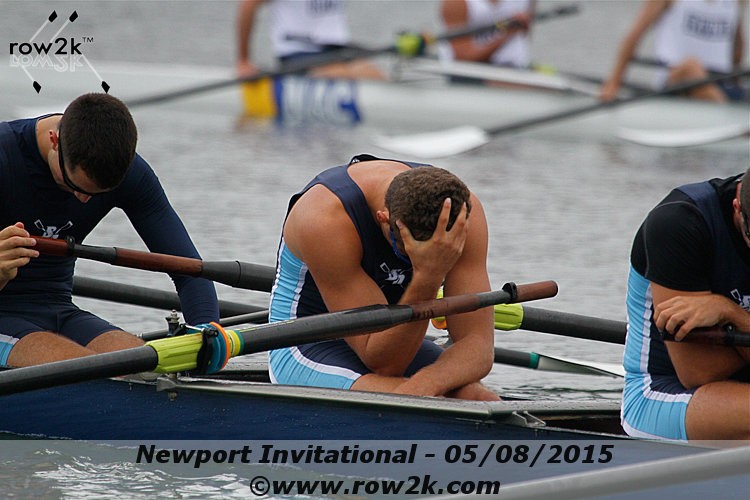Program Building Part 4 - Maintaining Buy-In

Following the cancellation of the 2020 spring racing season, row2k solicited the collegiate coaching community to engage in a variety of high-level topics within the profession. We submitted over sixty questions across a dozen topics and thank the coaches and staffs that found time to contribute their thoughts during this stressful time.
This week we focus on the topic of Program Building with the following question:
HOW DO YOU MAINTAIN 'BUY-IN' FROM ATHLETES WHEN THINGS AREN'T GOING WELL?
BART THOMPSON – ADRIAN
I think it starts out being really honest with the athletes from the beginning; if you’re faking anything you’re saying or doing they’ll be able to tell. I also think you need to treat them as intelligent adults and make sure they understand the “why”—why you’re training the way you train, etc.
We also talk a lot about not getting too high or too low, emphasizing that every successful team has its setbacks, and how you respond to those setbacks is much more important and telling than how you respond to successes. I also tend to speak anecdotally a lot, talking about other crews or even non-rowing teams/figures who have failed a lot before they triumphed, to have those as references for the athletes.
Then, if something goes poorly, you have a lot of past preparedness built up. The athletes understand why they’re doing what they’re doing in training, they understand that failure is a part of the process, and they understand that how we respond to that failure is what will determine whether or not we ultimately succeed.
ERIC GEHRKE – GEORGE WASHINGTON MEN
I believe if you keep the focus of the program on ‘process’ then a loss or a rough moment in competition is not a set-back but a way to ‘check-in’ with the process and learn forward from failure. With process as the focus then lots of the hard times that usually hit teams don’t feel so insurmountable anymore. The athletes are bought into improvement so are always focused forward to the next 1% incremental change. The trick is to stay true to that process; focus when things ARE going well and you want to stop and focus on the product on the race course.
EMILIE GROSS – NORTH CAROLINA WOMEN
Trust and commitment, I feel are some of the most important factors I can demonstrate to my student-athletes on a daily basis, and when that is a constant, the hard times will pass.
ETHAN SHOEMAKER – STETSON
This is perhaps the hardest part of building any team because things never go according to plan and then what do you do? Our first two years at Stetson our 2nd Varsity 8+ never won a race. So, while things looked to be improving for our top crew, our second 8 couldn’t seem to do anything right. It was tough on them and on us as coaches. Throughout those first two years, we never gave up on them, and we never lowered our standards for them. While they were losing, they were also improving. This spring our 2nd Varsity 8 won their only race of the season by a huge margin. We never gave up and the results were extremely gratifying when the victory finally came.
KEMP SAVAGE – EASTERN MICHIGAN WOMEN
You have to already have established a place where your athletes know that everything you do is for their success, not your own. You have to be a service to them, not to your own career or resume.
TODD KENNETT – CORNELL HEAVYWEIGHT MEN
Usually going back to find the positive steps and parts. Did you get stronger? Better technique? Better boat speed despite losses? Then work forward from there. Not everyone wins. Actually at least half of everyone loses on a given weekend, and on a championship weekend most people lose, so you have to find what you did well, and move with that. From there, build and find what the next step can be to bring the most gain to the crew. What are you missing, and how do your remedy it? (hopefully there is one) Show the crew they can take that step. Map it out so they can have some control of their ascent to speed. GIVE THEM HOPE! Have goals they can obtain besides winning races, so they feel good.
ALICEA STRODEL – MINNESOTA WOMEN
Communication is key; both one-on-one and to the team. Understanding where the athlete is coming from helps to create a path forward.
CAMPBELL WOODS – MARIST MEN
I think that it’s very important for coaches to have confidence in their plan. You are going to have times in the season where the athletes get run down or are in the hole mentally. I try to use three approaches to deal with this. The first is to have a program steeped in science. In sports psychology, we learn that athletes who understand WHY they are doing a workout are much more likely to implement that workout properly and well. So, everything we do is evidence based and grounded in the science of exercise physiology, kinesiology, and psychology.

The rowers aren’t just given workouts, they are given a training plan that explains to them down to the molecular level what the workouts are doing to their bodies over time. By doing this they can learn that they aren’t just blindly trusting the coach who is not just blindly making up workouts as they go along, but that they are following a broadly understood scientific concept to produce measurable improvements over an extended period of time.
Second, we try never to pile on when a guy is down but rather approach them privately and supportively and see if we can help. You’d be surprised how often a factor totally outside of rowing is really affecting someone’s performance at the boat house. Finally, we work with the athletes to triage and assess the situation.
Last spring our Marist V8 had a fantastic nearly undefeated season and then promptly fell flat on our faces at the Dad Vail and NIRC Regattas (both valiantly rowed but with substantial flaws). We had two major injuries in the top boat leading to championship weekend, but, even with this excuse, we spent several weeks with the athletes debriefing the season from start to finish and developing a deeper understanding of what led to this performance and what the coaches had done wrong or could change. We used what we learned to adjust our training plan in 2019-2020 and it made us a stronger crew. This willingness to take some credit for the team’s failure makes the athletes feel like you aren’t blaming them. It allows both sides to accept responsibility and ownership of a loss and enables all of you to develop solutions together rather than wasting time trying to decide who’s at fault.
JOHN BOYD – IONA
You have to continually remind them that this is a ‘process sport’. You can’t let them get too high on themselves when things are going well, and you can’t let them get too low when times are bad. The truth lies somewhere in the middle.
MARLEE BLUE – WASHINGTON WOMEN
I think there are two prongs to that question. In terms of it not going well, like our team not having a good result from a regatta, I think we maintain buy-in because we are internally focused. The boat is able to separate itself from the result and believes deeply in the journey that we are on to make that boat with all of its stories and personalities move through the water for 2000 meters as fast as it can.
As far as how we maintain buy-in when things don’t go well internally, or it's a hard time in people’s lives, I think we feel solidarity in it. If something were to happen it would be about how we handle it as a team, as opposed to how we handle it as individuals. I think the last thing is that we allow people space and time to cope and feel how they want to feel. Every person is an individual, and even though so much of rowing is forcing synchronization and discomfort, we don’t employ those same values when it comes to people’s emotions. Each person may face the same challenge in a completely different way and that is how we are strengthened, not divided.
JAMES TUCCI – SKIDMORE
As a coach my role is to help my athletes set realistic, yet ambitious short-term and long-term goals, and our focus is primarily intrinsic rather than extrinsic. For example, as a crew our standards for fitness and form might be a 6:35 2k with an effective quarter front end. Short -term goal setting would involve a realistic timeline toward achieving this standard, and charting erg scores and videotaping are used to monitor individual and team progress. Small successes on shorter term benchmarks increase motivation to continue working toward the ambitious goal.

If we set an extrinsic goal such as beating BigCrewU, we potentially set ourselves up for discouragement, as we have no control over BigCrew U’s boat speed. With that said, if we focus on the factors that improve our performance, leaving BigCrewU in our wake may be a positive outcome, but not an end in and of itself, as there will always be BiggerCrewUs to challenge.
Ultimately, as our boat speed improves, we may set more and more ambitious goals. The most important thing is to discuss and constantly reinforce, that in rowing, as in life, it is far more effective and rewarding to focus on the process, not the product. How are we going to achieve our ultimate boat-speed, not how are we going to beat, a specific rival?
ANONYMOUS HEAD COACH
Communication. As a coach I try to understand why the athlete isn’t acting in accord with the team. Maybe I, as the coach, need to adjust the why I am trying to reach that athlete. If there continues to be issues, we can delegate the matter to team leadership. Continued issues can be dealt with via team rules if necessary.
JAMIE FRANCIS – EMBRY-RIDDLE
I think this goes back to recruiting the right people and defining your success. Lining up against the top program in the conference after a spring break week of three-a-days and improving the margin from last year’s conference championship is a win. I think you maintain buy-in by making sure they see the big picture and show them progress; progress as a team and progress as an individual.
SANDRA CHU – WILLIAM SMITH WOMEN
I’ve had plenty of seasons where we haven’t had the speed we needed in order to achieve the performance goals we had. However, if I have provided strong leadership, the team still feels good about its performance and progress. This means I need to be honest with them about their potential and keep them focused on the process of improvement. If we stay focused on achieving small improvements each day as individuals and as a team, eventually we will develop the speed we want—or at the least, be satisfied that we did everything we could to be our best.
COLIN TRUEX – UC SAN DIEGO WOMEN
It is inevitable that there will be a rough patch; a series of practices, a race or two, perhaps even a whole season. It is easy to coach when things are going well, but we earn our paychecks when they aren’t. At this point you have to lean on trust. It is Ok to be honest and open with the athletes, to not sugarcoat the truth but to not let them give up either.

It is a real balancing act to demand harder work, technical changes, more toughness, whatever it may be, while at the same time staying positive and reminding them to ‘trust the process’. Setting micro-goals for practices/races during these times is a tactic that works as well, whether it is hitting a consistent split on the erg, or certain times on the water, they again can have that feeling of accomplishment, which can lead to better things!
Finally, make sure the team leaders are involved and keeping the lines of communication open between the athletes and coaches. If there is a ‘we are all in this together’ mindset you stand a pretty good chance of getting out of the rough patch.
LEE RUMPF – GEORGETOWN LIGHTWEIGHT MEN Keeping a team moving in the right direction in the face of disappointment is tough. A lot of your success here will come from doing things right on the front end. Is there a clear team goal? Does everyone have a good perspective on the bigger picture? Making sure athletes keep their eyes forward instead of backwards means you can more easily discuss what went well and how to apply it to the next race. It’s important to learn from failure but always with an eye towards how to find meaning and apply that next time around.
As a coach, I believe it’s important to own, or at least share ownership in a team’s failures. Having a coach take a share of the blame makes infighting less likely and increases trust between athlete and coach.
ROBERT BRADY – FRANKLIN & MARSHALL
When things aren't going well, say we underperformed at a race or had a bad practice, I try to take a step back and see where things went wrong. Ideally, it was just a fluke and had a bad day, but if it is something that is becoming a consistent issue, we will begin to focus on small attainable goals. We did this in our winter training this year; so rather than focus only on the results of 2K's, certain workouts were given small goals that were easily achievable for the athletes to build their confidence on the erg. Once that goal was achieved, a new one was set, and this led us to our 2K, where most people were feeling confident and excited to 2K because they knew they had already achieved these smaller goals along the way. This can be translated to on the water as well; maybe per practice, we have a specific goal of obtaining a specific split on a piece or achieving a technical change. Finding little goals to hit and achieving them helps build their confidence, regardless of race results.
YAZ FAROOQ – WASHINGTON WOMEN
As a coaching staff we have to be open, available--and vulnerable. It’s something we discuss as head coaches at UW all the time in meetings with our athletic director, Jen Cohen. Athletes and coaches are all human and working towards the same goal. By being approachable and human, I find we are able to have very honest conversations about how to move forward and help each other get to where we want to go.
ANONYMOUS HEAD COACH
That’s a good question and a hard one to really explain. I don’t know if there is a better example of why it is so important to be a transformational coach, and not a transactional one. When your athletes really know you care about them and have their best interest at heart, then you can be a unified squad, and you’re in it together. Then, lead with positivity and attitude. They will follow. But only if you have built those relationships.
COLIN FARRELL – PENN LIGHTWEIGHT MEN
First, I think it starts with bringing in the right kind of people. That begins for me with recruiting and hiring a staff. When people walk in the door with buy-in already, that makes things a lot easier when you have tough moments. You want people that understand what the sport is all about, people that have a passion for rowing, and want to be part of your team. I’ll use my assistant coach, Tyler, as an example since leadership starts with the tone the coaches are setting. He’s really good about being on the same page as me and understands where we’re trying to take the team, so when things aren’t going well, it’s really just about problem solving. There’s no blame to go around, it just becomes up to us to do a better job as a staff to help the squad. That helps keep things simple and productive.

From the athletes’ perspective, I would say that we as coaches and leaders can’t overreact when things aren’t going well. Success isn’t guaranteed and nothing comes easy, so everyone has to be prepared to struggle and work through that struggle. We try to identify some of those characteristics in recruiting. At Penn, we really value grit, perseverance, and a fighting spirit. Every team has bad practices and every athlete has bad days. So, it’s keeping things in perspective and continuing to work towards the finish line.
I like the quote, “If a problem can be solved there is no use worrying about it. And if it can't be solved, worrying will do no good.” Generally, in rowing, problems get solved by better teamwork, a more collective effort, better engagement, and more effective work. So, that’s what we try to remind the team of and push them to stay on task during down moments. You are never out of the race as long as you can change your boat speed. Once you get behind and you can’t go faster though, then you’re in trouble. So, it’s all about working to change your boat speed and the trajectory of the team if you’re not on track.
BRIAN PERKINS – TEMPLE MEN
Communication and TRUST is crucial. There have been books written on this so I will not elaborate too much.
If you enjoy and rely on row2k, we need your help to be able to keep doing all this. Though row2k sometimes looks like a big, outside-funded operation, it mainly runs on enthusiasm and grit. Help us keep it coming, thank you! Learn more.
Comments | Log in to comment |
There are no Comments yet
| |
- Bont Rowing
- Calm Waters Rowing
- Concept 2
- Craftsbury Sculling
- The Crew Classic
- CrewLAB
- Croker
- Durham Boat Co.
- Empacher
- Faster Masters
- Filippi
- Fluidesign
- h2row.net
- HUDSON
- Live2Row Studios
- Nielsen-Kellerman
- Oak Ridge RA
- Peinert Boat Works
- Pocock Racing Shells
- Race1 USA
- RowKraft
- Rubini Jewelers
- Vespoli USA
- WinTech Racing
- Bont Rowing
- Calm Waters Rowing
- Concept 2
- Craftsbury Sculling
- The Crew Classic
- CrewLAB
- Croker
- Durham Boat Co.
- Empacher
- Faster Masters
- Filippi
- Fluidesign
- h2row.net
- HUDSON
- Live2Row Studios
- Nielsen-Kellerman
- Oak Ridge RA
- Peinert Boat Works
- Pocock Racing Shells
- Race1 USA
- RowKraft
- Rubini Jewelers
- Vespoli USA
- WinTech Racing



















